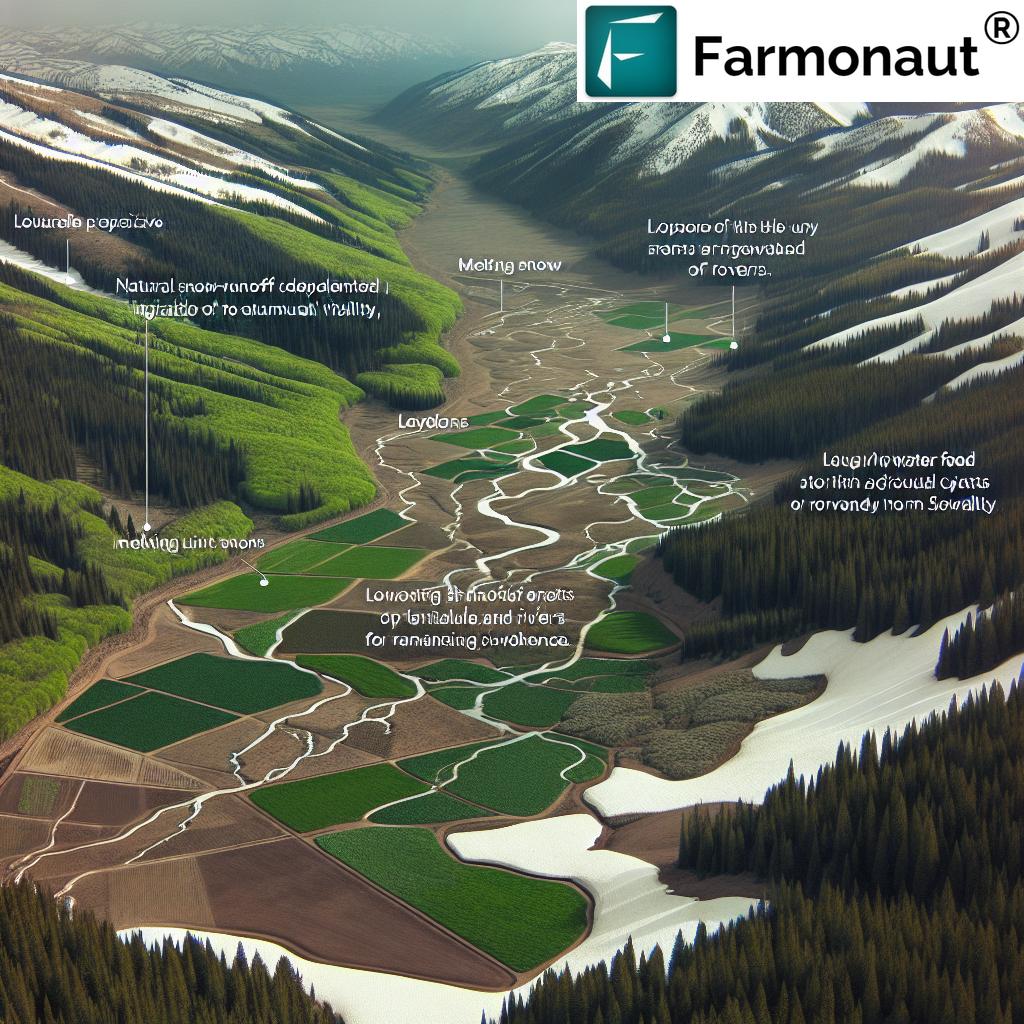Utah Snowpack Runoff: 7 Key Effects on Agriculture
“Utah’s snowpack provides up to 80% of the state’s annual water supply, crucial for sustainable agriculture.”
Introduction: Why Utah Snowpack Runoff Matters
In the vast arid landscapes of Utah, snowpack runoff remains the life-blood for both agricultural lands and forest ecosystems. As we navigate the complexities of modern farming and environmental stewardship, understanding how Utah snowpack runoff shapes water availability, crop growth, and forest health becomes more crucial than ever.
Our state’s unique geography means the majority of annual precipitation falls in the form of snow across the mountainous regions. As winter transitions to spring, this snowpack gradually melts, releasing essential water for our rivers, streams, and ultimately, every farm and forest dependent on its steady flow. However, emerging climate change patterns and rising temperatures threaten this natural cycle, forcing us all—farmers, foresters, and policymakers—to plan adaptive, sustainable responses.
The Importance of Utah Snowpack Runoff
Let’s examine why the Utah snowpack runoff is so foundational:
- Natural Reservoir: The snow that accumulates during winter acts as a vast, frozen reservoir, storing water for agricultural and forest use through spring and summer.
- Gradual Water Release: As temperatures rise, the melting process is generally spread out over weeks to months. This ensures rivers and streams are fed consistently, preventing drought shock and facilitating irrigation for crops and forests.
- Soil Moisture Replenishment: Gradual snowmelt soaks into soils, restoring vital soil moisture needed for planting, early crop growth, and forest vigor.
- Essential for Timing & Schedules: The timing and volume of runoff dictate the schedules for planting, irrigation, and harvesting across Utah’s farming communities.
- Forest Ecosystem Health: Forests rely on snowpack-fed streams to sustain tree health and maintain ecological balance.
In Utah, more than 80% of our water supply for agriculture and forestry derives directly from this annual snowmelt—making its predictability and sustainability indispensable for our way of life.
Climate Change and Its Impact on Utah Agriculture
As we look at the impact of climate change on Utah agriculture, it’s clear the snowpack’s role is shifting. The United States Environmental Protection Agency notes that our state has warmed about two degrees Fahrenheit in the last hundred years. This warming trend means:
- Earlier Melting: Higher spring temperatures cause snow to melt sooner, reducing the gradual availability of water.
- Lower Levels: Diminishing snowpack means less water overall, especially during crucial planting and growing months.
- Increased Variability: The timing and volume of runoff are less predictable, making farm and forest management more challenging.
- Extreme Weather: More frequent heat waves, droughts, and sporadic intense precipitation events disrupt the natural cycle of water availability.
These climatic shifts result in unpredictable changes in water supply, affecting irrigation, crop yields, livestock health, and forest resilience, ultimately disrupting both agricultural and forestry sectors. Let’s explore the most significant areas where Utah snowpack runoff impacts our region.
7 Key Effects of Utah Snowpack Runoff on Agriculture
Below, we detail how the Utah snowpack runoff affects farming, forests, and the broader environment, shaping the future of agriculture in our state:
- Crop Yields and Growth Patterns: The availability and timing of runoff directly influence soil moisture, seedling establishment, and crop development. Early or reduced snowmelt can stunt growth and lower annual yields.
- Water Availability for Irrigation: 80% of Utah’s annual irrigation water is sourced from snowpack runoff. Reduced precipitation and snow accumulation mean less water for both traditional farming and precision-agriculture practices.
- Livestock Health and Forage: Water scarcity affects pastures, reducing available feed as well as access to drinking water, ultimately threatening livestock well-being.
- Risk of Soil Erosion: Sudden, rapid melting often leads to surface runoff, stripping nutrients from soils and causing erosion in both crop lands and forested slopes.
- Forest Health in Utah: Drier landscapes caused by reduced snowpack increase stress on trees, elevate wildfire risk, and amplify pest/weed pressure.
- Pest and Weed Pressure: Unpredictable weather patterns and soil moisture variation foster conditions for pests to thrive—impacting both croplands and forests.
- Changing Irrigation Needs: As runoff patterns shift, farmers must adapt schedules and methods to suit altered water supplies, often incurring higher costs.
“In drought years, Utah’s snowpack runoff can decrease by over 40%, severely impacting crop irrigation and forest health.”
Comparative Impact Table: Utah Snowpack Runoff Effects
| Effect Area | Estimated Impact Level | Brief Description of Impact/Challenge |
|---|---|---|
| Crop Yields | High | Reductions in snowpack runoff can decrease crop yields by up to 15-25% (estimated); irrigation water deficiencies affect planting and maturation. |
| Water Availability | High | Less runoff results in limited water supply for agriculture; shortages trigger stricter water management and increased reliance on groundwater sources. |
| Livestock Health | Moderate to High | Reduced pasture irrigation and shrinking water sources can stress livestock, impacting weight gain, fertility, and health. |
| Forest Health | High | Diminishing snowpack runoff increases drought stress in forests, elevating pest infestation risk and mortality rates. |
| Soil Erosion | Moderate | Erratic runoff or rapid melting leads to soil erosion, nutrient loss, and sedimentation in streams. |
| Pest/Weed Pressure | Moderate | Changes in soil and plant health encourage pest proliferation (e.g., bark beetles, weeds), threatening crops and forests over thousands of acres. |
| Irrigation Needs | High | More intensive and adaptive irrigation practices are required as snowmelt and river flows become less predictable. |
Implications for Utah’s Agriculture
The effects of snowpack melt on crops and water cycles extend across the spectrum of Utah’s agricultural sectors. With agriculture heavily dependent on irrigation fed by Utah snowmelt, these are our primary concerns:
- Crop Stress and Lower Yields: Insufficient moisture during planting season disrupts seed germination, leading to lower yields, diminished produce quality, and increased risks of total crop failure. Monitoring real-time crop health (NDVI, soil moisture, pest indicators, etc.) is vital for responding to these shifts.
- Economic Pressures: Unpredictable scheduling, higher groundwater pumping costs, and investments in water-saving technologies pose new financial challenges for agricultural producers.
- Livestock Management: Dry pastures and limited stock water can force producers to reduce herd sizes, buy expensive feed, or relocate livestock.
- Altered Planting Schedules: As snowmelt timing shifts, traditional calendars for seeding, irrigation, and harvest may no longer apply, disrupting both small and large farm operations.
- Soil Degradation: Erratic melting and sudden runoff can wash away nutrient-rich topsoil, requiring additional soil fertility interventions or erosion control.
💧 Utah Irrigation Water Challenges
- Approximately 80% of Utah’s water is devoted to agricultural irrigation—meaning any change in snowpack runoff directly affects nearly every producer in the state.
- Farmers facing “unpredictable water availability” must increasingly deploy smart irrigation technologies and optimize water resource allocation.
- Using satellite-based crop monitoring through precision agriculture apps (like Farmonaut’s platform—Agro Admin App) helps mitigate these risks by enabling tailored, data-driven responses to changing field conditions.
Direct Effects on Utah’s Forests and Forestry
The forest health in Utah is inseparable from the snowpack. Spring runoff not only waters our rangelands and crops—it also sustains forested ecosystems and mitigates several risk factors. Here’s how:
- Drought Stress and Mortality: Drier soils and reduced stream flows weaken trees, exacerbating drought stress and dying off sensitive species.
- Elevated Wildfire Risk in Utah Forests: Parched conditions caused by early-melting, reduced snowpacks turn forests into tinderboxes. The risk, intensity, and frequency of wildfires increase significantly (heat waves and drier conditions fuel wildfire events).
- Pest Outbreaks: Stress from lack of water increases trees’ vulnerability to pests (e.g., bark beetles infesting tens of thousands of acres in 2012), threatening entire ecosystems.
🌲 Climate Change and Utah Forestry
The compounded impact of climate change—warmer winters, early snowmelt, extended drought—leads to transformations in both forest structure and function. For foresters and land managers, active monitoring and rapid response become essential to maintain ecosystem health and reduce losses from fires, disease, and pests. Tools like carbon footprint tracking support forest sustainability and environmental compliance.
Adaptation Strategies for Utah Farmers and Foresters
Faced with the challenges of variable snowpack runoff, we must implement actionable, science-backed strategies to protect Utah’s agricultural and forest resources. The path forward includes a mix of technological adoption, improved practices, and proactive resource management:
- Water Conservation:
- Installing efficient irrigation systems (like drip and sprinkler systems) reduces water wastage and optimizes plant hydration.
- Selecting drought-tolerant crop varieties minimizes yield loss during dry years.
- Leveraging real-time soil moisture data (as provided by Farmonaut’s platform) enables informed irrigation scheduling, minimizing overwatering and conserving runoff water.
- Forest Management:
- Conducting controlled burns and fuel reduction activities to decrease wildfire severity.
- Integrating satellite-based forest advisory services for ongoing monitoring of vegetation health, pest outbreaks, and fire risk.
- Diversification Strategies:
- Diversifying crop rotations, incorporating less water-intensive crops, and combining pastoral with arable farming to spread drought risk.
- Implementing alternate grazing systems and livestock management approaches during low runoff years.
- Policy and Financial Advocacy:
- Engaging in state and federal policy discussions to secure water rights and funding for water infrastructure upgrades.
- Utilizing tools such as satellite-based crop loan and insurance verification for better risk and finance management.
- Resource Tracking and Transparency:
- Using fleet and resource management solutions to minimize operational costs and optimize farm logistics.
- Ensuring supply chain traceability and transparency through blockchain-based product traceability.
Farmonaut: Satellite-Based Technology for Sustainable Agriculture
Modern agriculture in Utah demands affordable, accessible tools for real-time decision-making. This is where Farmonaut excels, empowering our farmers, foresters, and agribusinesses to monitor the ever-changing landscape of Utah snowpack runoff and water availability, optimize inputs, and embrace sustainable, precision-based practices.
-
Satellite Crop Health Monitoring:
With farm health monitoring via satellite (NDVI, soil moisture, LAI), Farmonaut users receive up-to-date visuals and analytics on crop vigor and water stress. This precision allows rapid interventions, supporting robust yields even in challenging snowmelt seasons. -
AI-Powered Farm Advisory:
The Jeevn AI Advisory System delivers personalized water management guidance, pest alerts, and weather forecasts, all tailored to current conditions reported by satellites. -
Traceability and Transparency:
Blockchain traceability tools assure buyers and regulators of sustainable sourcing and environmental responsibility throughout the journey from Utah’s fields to the market. -
Carbon Footprinting:
Farmonaut’s carbon tracking module supports environmental compliance and helps agri-clients measure and reduce the climate impact of their practices. -
Accessible Solutions:
We offer scalable subscription plans (see below) with both web and mobile access, plus a robust API for developers and agribusiness platforms (read full API developer docs).
Frequently Asked Questions (FAQ) – Utah Snowpack Runoff & Agriculture
What is Utah snowpack runoff, and why is it important for agriculture?
Utah snowpack runoff refers to the gradual melting of accumulated mountain snow, which releases water into rivers and streams during spring and summer. This runoff provides up to 80% of our state’s annual water supply, directly feeding irrigation systems, supporting crop growth, replenishing soil moisture, and sustaining forest ecosystems.
How does climate change affect Utah snowpack and runoff patterns?
Climate change introduces warmer winters and earlier springs, reducing the amount of snow that accumulates and causing it to melt sooner. This shifts the timing of water availability, increases the unpredictability of runoff, and can reduce total water volume, presenting major Utah irrigation water challenges.
What are the main agricultural risks associated with diminished snowpack runoff?
The primary risks include lower crop yields, inadequate soil moisture, stressed livestock due to lack of forage and water, and increased soil erosion. Solutions involve technology adoption (crop monitoring, irrigation scheduling, pest detection), and active management approaches.
How are Utah’s forests affected by changes in snowpack runoff?
Reduced snowpack means less water for trees and forest soils, leading to drought stress, heightened wildfire risk in Utah forests, and increased vulnerability to pests like bark beetles. These factors can result in large-scale tree mortality and ecosystem disruption.
What adaptation strategies can Utah farmers and foresters use?
Our best adaptation strategies include water conservation via efficient irrigation, adoption of drought-resistant crops, use of satellite-based monitoring tools, forest management, diversification of operations, and advocacy for improved policy and water infrastructure support.
How does Farmonaut’s technology support these adaptation efforts?
Farmonaut offers real-time satellite-based monitoring for crop and forest health, personalized AI advisory systems for optimal farm management, blockchain-based supply chain traceability, carbon footprint tracking, API integration for developers, and comprehensive farm management dashboards. These tools make precision agriculture accessible and affordable, empowering our community for a sustainable future.
Where can I access Farmonaut’s solutions?
Farmonaut can be accessed via web and mobile apps (Android and iOS), as well as our developer API. Farmers, agribusinesses, NGOs, and government bodies benefit from scalable, subscription-based tools designed for modern agriculture.
Conclusion: Building a Sustainable Future for Utah Agriculture and Forests
The Utah snowpack runoff stands at the intersection of agriculture, forestry, and environmental health. In an era of warming climates, variable precipitation, and increasingly unpredictable water cycles, we must adapt and innovate.
By integrating detailed monitoring, AI-driven decision tools, and transparent supply chains—using platforms like Farmonaut—Utah’s agriculture and forestry sectors can continue to thrive while embracing sustainability and resilience. Together, we can optimize planting, protect our lands, conserve water, respond to challenges, and secure a sustainable future for our communities and environment.
Let us all be stewards of Utah’s snow, water, forests, and fields—balancing productivity with ecological care for generations to come.






















